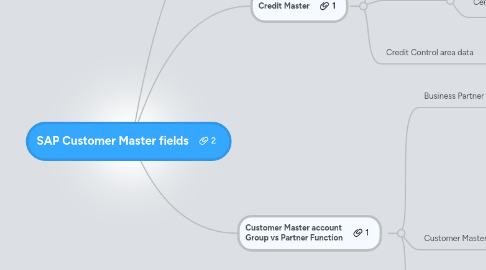
1. Credit Master
1.1. Overview
1.2. General data
1.2.1. Address
1.2.2. Central Data
1.3. Credit Control area data
1.3.1. Status
1.3.2. Payment history
2. Customer Master account Group vs Partner Function
2.1. Business Partner
2.1.1. Any customer, entity, employee,.. that has a role in a business transaction
2.1.2. Customer Examples: Sold-to, Ship-to, Bill-to, Payer, Contact person(s)
2.1.3. Employee Examples: CSR, Sales Rep, Credit Rep
2.1.4. They all are created as master data in SAP before they can be used on a transaction
2.2. Customer Master Account group
2.2.1. Master Data
2.2.2. Controls
2.2.2.1. Number Range assignment
2.2.2.2. Internal or External Customer numbering
2.2.2.3. Make fields required/optional/hidden
2.2.3. Examples: Sold-to Party [0001], Ship-to Party [0002], Payer [0003], Bill-to Party [0004]
2.3. Partner Function
2.3.1. Included in the Partner Master data to define relationships and defaults, but really used in the Transaction data
2.3.2. Defines the Roles and Responsibilities of the Business Partner
2.3.3. A customer created as a Sold-to Party account group [0001], can be assigned to multiple partner functions
2.3.4. Examples: Sold-to [SP], Ship-to [SH], Payer [PY], Bill-to [BP]
3. Customer Master
3.1. General Data
3.1.1. Address
3.1.1.1. Name
3.1.1.2. Search Terms
3.1.1.3. Street Address
3.1.1.4. PO Box Address
3.1.1.5. Communication
3.1.2. Control Data tab
3.1.2.1. Account Control section
3.1.2.2. Reference data/area
3.1.2.3. Tax information
3.1.3. Payment Transactions tab
3.1.3.1. Bank Details
3.1.3.2. Payment Transactions
3.1.4. Marketing tab
3.1.4.1. Classification
3.1.4.2. Key Figures
3.1.4.3. Sales Prospecting
3.1.5. Unloading Points tab
3.1.5.1. Unloading points
3.1.6. Export Data tab
3.1.6.1. Export data
3.1.6.2. Usage
3.1.6.3. Classification
3.1.7. Contact Person tab
3.1.7.1. Contact person
3.1.8. Additional Data
3.1.8.1. Freely definable attributes
3.1.8.2. For condition determination and pricing
3.1.9. Texts
3.1.10. Classification
3.1.11. Payment Cards
3.1.12. Link to Documents
3.2. Company Code Data
3.2.1. Account Management
3.2.1.1. Accounting information
3.2.1.2. Interest calculation
3.2.1.3. Reference data
3.2.2. Payment Transactions
3.2.2.1. Payment data
3.2.2.2. Automatic Payment transactions
3.2.3. Correspondence
3.2.3.1. Correspondence
3.2.4. Texts
3.3. Sales Organization Data
3.3.1. Sales
3.3.1.1. Sales Order
3.3.1.2. Pricing statistics
3.3.1.3. Agency business
3.3.2. Shipping
3.3.2.1. Shipping
3.3.2.2. Partial deliveries
3.3.2.3. General transportation data
3.3.3. Billing documents
3.3.3.1. Billing documents
3.3.3.2. Delivery and Payment terms
3.3.3.3. Accounting
3.3.3.4. Taxes
3.3.4. Partner Functions
3.3.5. Additional data
3.3.6. Texts
3.4. Other data
3.4.1. Blocking Data
3.4.2. Deletions Flags
